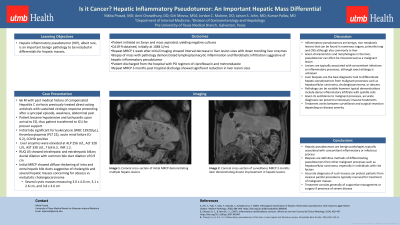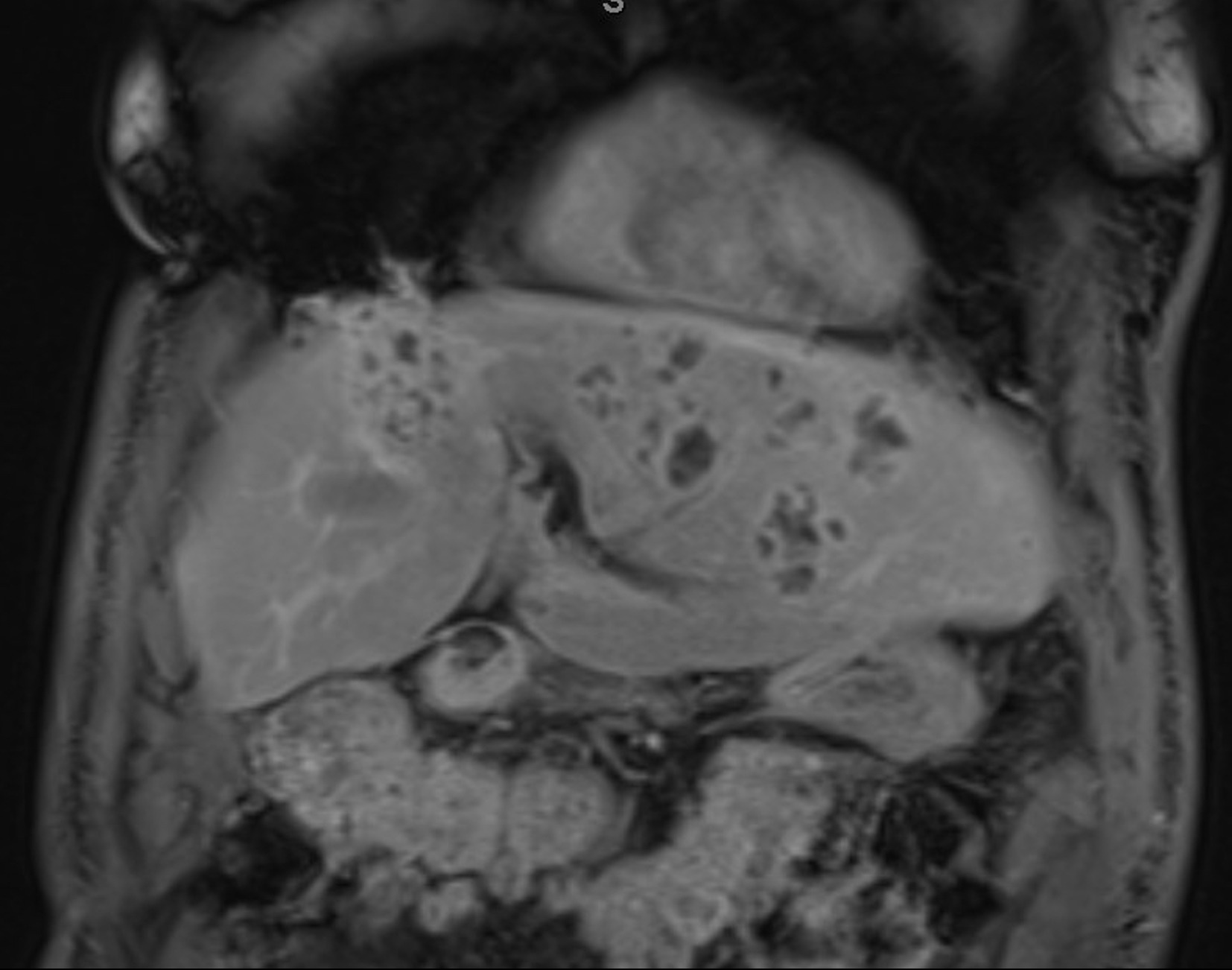Back


Poster Session C - Monday Afternoon
Category: Liver
C0566 - Is It Cancer? Hepatic Inflammatory Pseudotumor: An Important Hepatic Mass Differential
Monday, October 24, 2022
3:00 PM – 5:00 PM ET
Location: Crown Ballroom

Has Audio

Nikita Prasad, MD
University of Texas Medical Branch
Galveston, TX
Presenting Author(s)
Nikita Prasad, MD1, Anni Chowdhury, DO1, Giri Movva, BS2, Jordan C. Malone, DO1, Jaison John, MD1, Kumar Pallav, MD3
1University of Texas Medical Branch, Galveston, TX; 2John Sealy School of Medicine, University of Texas Medical Branch, Galveston, TX; 3UTMB, Galveston, TX
Introduction: Hepatic inflammatory pseudotumor (HIP), albeit rare, is an important pathology to be included in differentials for hepatic masses. The benign nature and treatment of this disease process should be considered especially in comparison to malignant hepatic processes.
Case Description/Methods: A 66-year-old male with pre-existing history of compensated Hepatitis C cirrhosis status post direct-acting antivirals with sustained virologic response presented in shock after a syncopal episode. Initial work up revealed leukocytosis, thrombocytopenia, acute renal injury, elevated liver enzymes, and COVID-19 positive test. Patient underwent initial liver ultrasound revealing intrahepatic and extrahepatic biliary ductal dilation. Subsequent MRCP demonstrated diffuse thickening of intra and extra hepatic bile ducts suggestive of cholangitis and several hepatic masses concerning for abscesses versus possible metastatic cholangiocarcinoma. Patient improved symptomatically with antibiotics and supportive care. A liver biopsy was performed with pathology showing lymphoplasmacytic inflammation and fibroblastic infiltration suggestive of hepatic inflammatory pseudotumor. A repeat MRCP one week later showed interval decrease in size of liver lesions and repeat liver function tests also showed improvement. Patient was discharged on a course of ciprofloxacin and metronidazole. Patient had repeat MRCP 3 months after discharge, with further significant improvement in size of liver lesions. After multi-disciplinary discussion the plan was for further surveillance with imaging and labs in 2 months.
Discussion: Inflammatory pseudotumors are benign and non-neoplastic lesions that can occur in any organ. They can appear as a malignant lesion when they arise in the liver and an accurate identification can allow for conservative management and prevent unnecessary invasive procedures. Hepatic inflammatory pseudotumors are often seen with concomitant infection or inflammatory processes. Liver biopsies distinguish these tumors from other malignant processes as they demonstrate a characteristic dense inflammatory infiltrate interspersed in stroma of interlacing bundles of myofibroblasts. This case highlights the importance of maintaining HIP on the differential diagnosis.

Disclosures:
Nikita Prasad, MD1, Anni Chowdhury, DO1, Giri Movva, BS2, Jordan C. Malone, DO1, Jaison John, MD1, Kumar Pallav, MD3. C0566 - Is It Cancer? Hepatic Inflammatory Pseudotumor: An Important Hepatic Mass Differential, ACG 2022 Annual Scientific Meeting Abstracts. Charlotte, NC: American College of Gastroenterology.
1University of Texas Medical Branch, Galveston, TX; 2John Sealy School of Medicine, University of Texas Medical Branch, Galveston, TX; 3UTMB, Galveston, TX
Introduction: Hepatic inflammatory pseudotumor (HIP), albeit rare, is an important pathology to be included in differentials for hepatic masses. The benign nature and treatment of this disease process should be considered especially in comparison to malignant hepatic processes.
Case Description/Methods: A 66-year-old male with pre-existing history of compensated Hepatitis C cirrhosis status post direct-acting antivirals with sustained virologic response presented in shock after a syncopal episode. Initial work up revealed leukocytosis, thrombocytopenia, acute renal injury, elevated liver enzymes, and COVID-19 positive test. Patient underwent initial liver ultrasound revealing intrahepatic and extrahepatic biliary ductal dilation. Subsequent MRCP demonstrated diffuse thickening of intra and extra hepatic bile ducts suggestive of cholangitis and several hepatic masses concerning for abscesses versus possible metastatic cholangiocarcinoma. Patient improved symptomatically with antibiotics and supportive care. A liver biopsy was performed with pathology showing lymphoplasmacytic inflammation and fibroblastic infiltration suggestive of hepatic inflammatory pseudotumor. A repeat MRCP one week later showed interval decrease in size of liver lesions and repeat liver function tests also showed improvement. Patient was discharged on a course of ciprofloxacin and metronidazole. Patient had repeat MRCP 3 months after discharge, with further significant improvement in size of liver lesions. After multi-disciplinary discussion the plan was for further surveillance with imaging and labs in 2 months.
Discussion: Inflammatory pseudotumors are benign and non-neoplastic lesions that can occur in any organ. They can appear as a malignant lesion when they arise in the liver and an accurate identification can allow for conservative management and prevent unnecessary invasive procedures. Hepatic inflammatory pseudotumors are often seen with concomitant infection or inflammatory processes. Liver biopsies distinguish these tumors from other malignant processes as they demonstrate a characteristic dense inflammatory infiltrate interspersed in stroma of interlacing bundles of myofibroblasts. This case highlights the importance of maintaining HIP on the differential diagnosis.

Figure: Coronal cross section of MRCP demonstrating numerous hepatic masses.
Disclosures:
Nikita Prasad indicated no relevant financial relationships.
Anni Chowdhury indicated no relevant financial relationships.
Giri Movva indicated no relevant financial relationships.
Jordan Malone indicated no relevant financial relationships.
Jaison John indicated no relevant financial relationships.
Kumar Pallav indicated no relevant financial relationships.
Nikita Prasad, MD1, Anni Chowdhury, DO1, Giri Movva, BS2, Jordan C. Malone, DO1, Jaison John, MD1, Kumar Pallav, MD3. C0566 - Is It Cancer? Hepatic Inflammatory Pseudotumor: An Important Hepatic Mass Differential, ACG 2022 Annual Scientific Meeting Abstracts. Charlotte, NC: American College of Gastroenterology.
